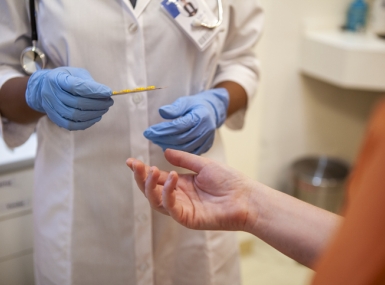Garrett County, Md. wins RWJF’s Culture of Health Prize
Author

Blaire Bryant
Upcoming Events
Related News
Garrett County, Md. is one of eight RWJF Culture of Health winners for its wellness efforts
Garrett County, Maryland, a rural Appalachian community that borders Pennsylvania and West Virginia, is gaining national recognition as one of eight winners of the 2017 Robert Wood Johnson Foundation’s Culture of Health Prize. The award, which is given annually and comes with a $25,000 prize, recognizes communities for their sustained efforts to ensure all residents have the opportunity to live healthier, happier lives. Garrett County is the first community in Maryland to receive this award.
Poverty at its root
At the heart of Garrett County is Deep Creek Lake, a vacation destination that has for years brought both a hefty tourism economy and notoriety to the region. But beyond the multimillion dollar homes and rapidly expanding condo developments surrounding Deep Creek Lake, is a community of residents who are grappling with poverty. The most recent County Health Rankings snapshot puts the unemployment rate in Garrett County at 6.5 percent, nearly double that of other top performing counties in the United States and indicates that 19 percent of children in this county are currently living in poverty.
Aiming for total wellness
Nonetheless, the residents and leaders of Garrett County are dedicated and determined to tackle poverty through solutions aimed at improving education, housing, jobs and health. When Jim Hinebaugh, now one of three county commissioners, returned to Garrett County after his military service in 1995 to become the director of economic development, it seemed as if the county’s economic status had hit rock bottom. At that time, the county’s largest employer, Bausch & Lomb Inc., the producer of Ray Ban sunglasses, announced it was closing its manufacturing plant, taking over 600 jobs with it. By early 1997, the unemployment rate had spiked to nearly 13 percent.
Learn More
Hinebaugh began working with local elected officials, state officials, state and federal agencies, and business and community leaders to develop the county’s first Strategic Plan for Economic Development. While examining the county’s unemployment issues and analyzing its economic challenges, he realized the importance of educational attainment as an indicator of lifelong earning. The county’s economic well-being was inextricably tied to developing a skilled and educated workforce, and the driving force was postsecondary education.
After his proposal to provide four scholarships to Garrett College was abruptly rebuffed, he went back and did the math. He calculated that the county could give every high school graduate a two-year scholarship at Garrett College, and it would only cost 1 penny on the tax rate. The scholarship program was adopted and implemented by Garrett College in 2006, and was widely received by both county officials and residents alike. It currently gives Garrett County residents who have obtained a high school degree or GED a free two-year scholarship provided that they are enrolled full-time and maintain a 2.0 grade-point average. In 2009, the program was expanded to “trade training” in which students could obtain certificates for specialty skills such as welding and nursing, or earn their commercial driver's license.
However, this community cares about more than just its economy. When Garrett Regional Medical Center, a 55-bed nonprofit acute care facility and affiliate of West Virginia University, evaluated the rates of patient re-admission to the emergency department, they discovered a core group of individuals that were being readmitted at consistently high rates.
“People with chronic diseases tend to be people you see in your emergency department on a somewhat regular basis,” said Kimi-Scott McGreevy, public relations director at Garrett Regional Medical Center. Individuals would be sent home, and because they lack the tools to properly do so, would not change their approach to their disease. “The information just wasn’t sticking.”
The Well Patient Program was borne out of an effort to better serve this population and ensure that treatment and care did not end at the emergency department doors. Through the well patient program, patients are given a stake in their own health outcomes by serving as “equal members of their own healthcare team,” McGreevy said.
At discharge after an emergency room visit, patients are provided with a team, comprising a social worker, primary care physician and a community health worker — a peer navigator working to bridge the gap between the patient and their care needs. The idea behind the creation of community health workers was to help guide individuals living with a chronic condition through some of the social factors that serve as barriers to their care or exacerbated their condition.
“Health crises were being triggered by other things going on in the person’s life … like a utility being shut off, not being able to make the rent this month,” she said.
Community health workers, who are hospital employees who are also living with chronic conditions, are an empowering resource for patients, or as Kimi-Scott said, “They’re like a living example of 'you can do this.'"
It doesn’t stop there. The county has a plan for total wellness from childhood to adulthood, made evident through programs such as its 2-Generation (2-G) initiative, which seeks to address intergenerational poverty by advocating for family success. or the “Learning Beyond the Classroom” mobile classroom, which is aimed at increasing school readiness for children ages 0–5 by providing them with lessons, nutrition and cooking activities, literature and art experiences, as well as valuable play experiences — all at their doorsteps.
Deep-rooted strength
The shared vision of Garrett County residents, government and local organizations was the foundation for their success. The deep-rooted spirit of collaboration has long been established in this county, dating back to the creation of the Health Planning Council in 1999. The council, composed of community members and partners from all community sectors including health care, government and public health, was formed to ensure that residents were receiving high quality, integrated care.
Community members have themselves served as the catalyst for change and are often the drivers of these initiatives. Not only are they actively participating in initiatives by volunteering and attending council meetings, but they are tracking the progress of county efforts through the online planning tool, MyGarrettCounty.com.
Other key players include the Garrett County Health Department, that among other things, implemented the nurse home visiting program for new moms and Garrett County Community Action Committee, Inc., a poverty reduction nonprofit that provides a number of different services for the county.
When it comes to creating a culture of health, the role of county government is not lost on this community. Commissioner Hinebaugh underscores the importance of county commissioners and elected officials supporting the type of work that cultivates healthier lifestyles for residents. “It’s our job to set the tone and to provide the leadership and the vision,” Hinebaugh said.
Looking ahead
Post win, planners and leaders in Garrett County are looking to take on other large community issues such as transportation. The Garrett Regional Medical Center received a grant from the state of Maryland to buy a car for the community health workers who participate in the Well Patient Program. They wanted to make it easier for the community health workers to provide transportation for patients without racking up miles on their own vehicles. “We are going to build on this program and the community health workers,” McGreevy said. “We just want it to grow."
Hinebaugh hopes the community will continue to generate programs that promote economic growth and bring people back to Garrett County such as the county’s partnership with the state of Maryland’s “Pathway to Home Ownership Program,” which provides an additional $7,500 in down payment assistance to individuals purchasing a home in Garrett County, in the form of a forgivable grant. Recognizing that affordable housing is a challenge in this community, Hinebaugh lauds this initiative: “It’s just another creative and innovative thing we’ve done to try to make the county a better place to live.”
The Robert Wood Johnson Foundation has worked for more than 40 years with the mission to improve health and health care. The foundation works with others to build a national culture of health enabling all Americas to live longer, healthier lives.
Attachments
Related News

U.S. House reintroduces legislation to address the Medicaid Inmate Exclusion Policy
Two bipartisan bills aimed at addressing the Medicaid Inmate Exclusion Policy (MIEP) were recently reintroduced in the U.S. House of Representatives.

House E&C Committee advances SUPPORT Act reauthorization
On April 9, the U.S. House Energy and Commerce Committee marked up the SUPPORT for Patients and Communities Reauthorization Act of 2025. The bipartisan bill aims to reauthorize critical programs that target overdose prevention amid the renewal of the opioid crisis Public Health Emergency declaration.

Bird flu update: What county leaders should know
As of April 7, there have been 70 confirmed cases of bird flu in the United States, but no person-to-person spread has been detected.